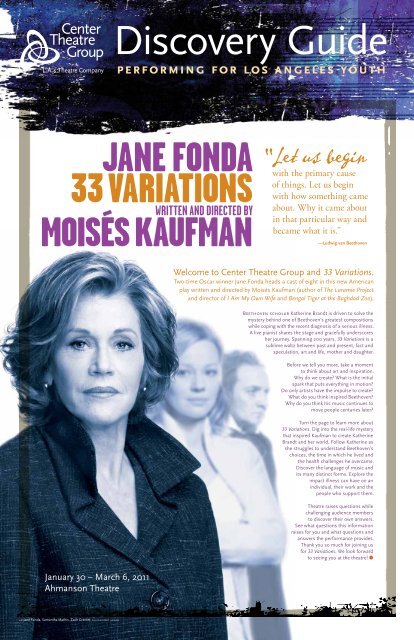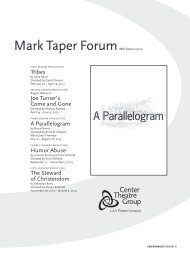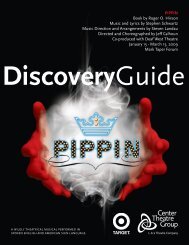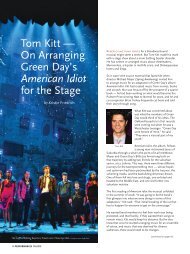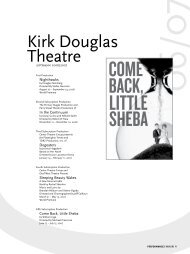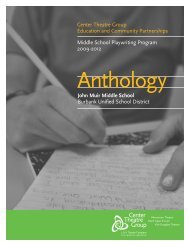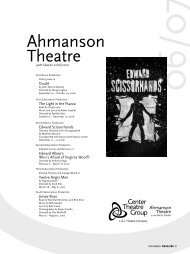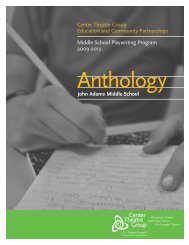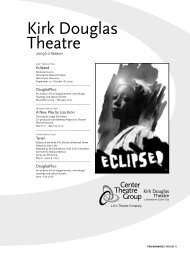33 Variations - Center Theatre Group
33 Variations - Center Theatre Group
33 Variations - Center Theatre Group
You also want an ePaper? Increase the reach of your titles
YUMPU automatically turns print PDFs into web optimized ePapers that Google loves.
January 30 – March 6, 2011<br />
Ahmanson <strong>Theatre</strong><br />
l-r: Jane Fonda, Samantha Mathis, Zach Grenier. photo by greg heisler<br />
Discovery Guide<br />
“Let us begin<br />
with the primary cause<br />
of things. Let us begin<br />
with how something came<br />
about. Why it came about<br />
in that particular way and<br />
became what it is.”<br />
—Ludwig van Beethoven<br />
Welcome to <strong>Center</strong> <strong>Theatre</strong> <strong>Group</strong> and <strong>33</strong> <strong>Variations</strong>.<br />
Two-time Oscar winner Jane Fonda heads a cast of eight in this new American<br />
play written and directed by Moisés Kaufman (author of The Laramie Project<br />
and director of I Am My Own Wife and Bengal Tiger at the Baghdad Zoo).<br />
Beethoven scholar Katherine Brandt is driven to solve the<br />
mystery behind one of Beethoven’s greatest compositions<br />
while coping with the recent diagnosis of a serious illness.<br />
A live pianist shares the stage and gracefully underscores<br />
her journey. Spanning 200 years, <strong>33</strong> <strong>Variations</strong> is a<br />
sublime waltz between past and present, fact and<br />
speculation, art and life, mother and daughter.<br />
Before we tell you more, take a moment<br />
to think about art and inspiration.<br />
Why do we create? What is the initial<br />
spark that puts everything in motion?<br />
Do only artists have the impulse to create?<br />
What do you think inspired Beethoven?<br />
Why do you think his music continues to<br />
move people centuries later?<br />
Turn the page to learn more about<br />
<strong>33</strong> <strong>Variations</strong>. Dig into the real-life mystery<br />
that inspired Kaufman to create Katherine<br />
Brandt and her world. Follow Katherine as<br />
she struggles to understand Beethoven’s<br />
choices, the time in which he lived and<br />
the health challenges he overcame.<br />
Discover the language of music and<br />
its many distinct forms. Explore the<br />
impact illness can have on an<br />
individual, their work and the<br />
people who support them.<br />
<strong>Theatre</strong> raises questions while<br />
challenging audience members<br />
to discover their own answers.<br />
See what questions this information<br />
raises for you and what questions and<br />
answers the performance provides.<br />
Thank you so much for joining us<br />
for <strong>33</strong> <strong>Variations</strong>. We look forward<br />
to seeing you at the theatre! ●
inside<br />
About the Play 2<br />
Beethoven and Music 4<br />
Fragility and Resilience 6<br />
Moisés Kaufman<br />
interview<br />
7<br />
Here Be Dragons 8<br />
601 West Temple Street<br />
Los Angeles, CA 90012<br />
Education and<br />
Community Partnerships<br />
<strong>Center</strong><strong>Theatre</strong><strong>Group</strong>.org/<br />
Education<br />
Audience Services<br />
213.628.2772<br />
<strong>Center</strong><strong>Theatre</strong><strong>Group</strong>.org<br />
<strong>Theatre</strong> Locations<br />
Mark Taper Forum<br />
Ahmanson <strong>Theatre</strong><br />
at the Music <strong>Center</strong><br />
135 North Grand Avenue<br />
Los Angeles, CA 90012<br />
Kirk Douglas <strong>Theatre</strong><br />
in downtown Culver City<br />
9820 Washington Blvd.<br />
Culver City, CA 90232<br />
Discovery Guide<br />
Educational Materials Team:<br />
Writer<br />
Megan Mathews<br />
Associate Director of Education<br />
and Community Partnerships<br />
Debra Piver<br />
Educational Communications<br />
Coordinator<br />
Jim Halloran<br />
Performing for Los Angeles Youth<br />
(P.L.A.Y.) Project Faculty<br />
Lynn Clark<br />
Leslie Ishii<br />
Marcos Najera<br />
Michael Yurchak<br />
Proofreader<br />
Kelly Thacher<br />
Graphic Designer<br />
Christopher Komuro<br />
2 <strong>33</strong> <strong>Variations</strong><br />
About the PlAy<br />
Musicologist Dr. Katherine Brandt is obsessed with<br />
an obsession. She’s an expert on Ludwig van Beethoven,<br />
but one thing baffles her — Beethoven’s Diabelli <strong>Variations</strong>.<br />
In <strong>33</strong> <strong>Variations</strong>, writer/director Moisés Kaufman allows past<br />
and present to intertwine, bringing two people, separated<br />
by centuries but united by a shared passion, close enough<br />
to touch.<br />
In 1819, music publisher Anton Diabelli invited 50 of<br />
Europe’s most respected and accomplished composers<br />
to create a variation on a waltz he had written. Everyone<br />
accepted the commission right away. Everyone, that is, but<br />
Beethoven. History records that Beethoven felt the piece was<br />
beneath him, or “schusterfleck” (cobbler’s patch). For some<br />
reason, though, he changed his mind. Interrupting work on<br />
his 9th Symphony and Missas Solemnis, Beethoven spent four<br />
years exploring and transforming every note of Diabelli’s<br />
waltz until he had not one but <strong>33</strong> variations on the seemingly<br />
simple theme. What compelled Beethoven to put so much of<br />
himself into this commission when he had nobler works to<br />
complete and rapidly deteriorating health to contend with?<br />
Katherine has a theory. She believes that Beethoven<br />
wanted to show the world how he could make something<br />
magnificent out of something trivial. That is her hypothesis<br />
but she wants to be sure. The only way to do that is to<br />
see, first hand, Beethoven’s original sketchbooks — the<br />
journals of his ideas, impulses and revisions — all in his<br />
most casual, unselfconscious handwriting. Katherine hopes<br />
Beethoven’s pencil marks will reveal the truth to her across<br />
time, through the dusty stacks of books in his official<br />
archive, the Beethoven-Haus in Bonn, Germany.<br />
For Katherine, a trip to Bonn is the pinnacle of her life’s<br />
work. Not even the diagnosis of ALS (Lou Gehrig’s Disease)<br />
will stop her from going. Her daughter, Clara, is terrified<br />
and wants Katherine to stay in New York. When Katherine<br />
In <strong>33</strong> <strong>Variations</strong> writer/director Moisés Kaufman<br />
explores the mystery of the creative impulse.<br />
Why do we create? What is the spark that puts<br />
everything in motion?<br />
Kaufman’s impulse to create <strong>33</strong> <strong>Variations</strong><br />
came from a sales clerk at Tower Records who told<br />
him of the mystery behind the Diabelli <strong>Variations</strong>.<br />
Kaufman’s curiosity about Beethoven’s obsession<br />
began a five-year journey across the globe,<br />
through thousands of primary source documents<br />
in libraries and archives; and into theatres and<br />
rehearsal rooms with actors, musicians, writers<br />
and artists. Every new discovery fed his curiosity<br />
and ultimately compelled him to create this play<br />
— a play about the impulse to create. ●<br />
refuses, Clara and her boyfriend Mike — a nurse with<br />
experience treating ALS patients — follow Katherine to<br />
Bonn. Clara knows her mother is running out of time<br />
and hopes to repair their strained relationship before it’s<br />
too late.<br />
In Bonn, Katherine meets Dr. Gertrude (Gertie) Ladenburger,<br />
Beethoven-Haus Librarian. They pour over every page of<br />
Beethoven’s sketchbooks. As they piece together clues<br />
from those pages — mysterious stains and missing<br />
passages — the past opens up to reveal Beethoven’s world<br />
in 1820’s Germany and Austria. We see Beethoven rage,<br />
create and battle the pressures of time. His struggles are<br />
made bearable by a unique support system — an unpaid<br />
secretary, Anton Schindler, and an impatient (albeit often<br />
accommodating) music publisher, Anton Diabelli.<br />
Katherine hopes Beethoven’s<br />
pencil marks will reveal<br />
the truth to her across time.<br />
In <strong>33</strong> <strong>Variations</strong>, Beethoven struggles with chronic poor<br />
health, progressive deafness and a set of variations<br />
whose end elude him. Katherine pushes through rapidly<br />
degenerating motor control, disappointment in her daughter<br />
and the mystery of Beethoven’s obsession. Clara tries to<br />
make sense of her life choices, her mother’s lack of affection<br />
and the possibility of love. Three people. Three intertwined<br />
sets of challenges. Relationships in alternating pairs and<br />
triangles, revolving around each other and through time. ●<br />
Think of something you have created in<br />
your own life: music, art, a school project,<br />
a meal, a friendship, a fashion style.<br />
Can you remember your initial inspiration?<br />
Where did that inspiration take you?<br />
Beethoven’s sketches. Set design by Derek McLane.
“Variation form<br />
allows Beethoven to<br />
do the miraculous and<br />
slow down time,<br />
to pierce the waltz<br />
and enter the minutia<br />
that life<br />
in its haste,<br />
robs us of.”<br />
Zach Grenier (background) and Jane Fonda in <strong>33</strong> <strong>Variations</strong>. photo by joan marcus<br />
—Dr. Katherine Brandt in <strong>33</strong> <strong>Variations</strong><br />
We live in a fast paced world. Information can be relayed instantly. We can<br />
travel across the world in hours rather than months. Deadlines and pressures of<br />
modern life can result in the common feeling of “not enough time.”<br />
In <strong>33</strong> <strong>Variations</strong>, the characters plead,<br />
“I nEED MoRE TIME. THERE IS noT EnouGH TIME.”<br />
Time to create, to be with the one you love, to solve a mystery, to repair a<br />
relationship or to complete your life’s passion. Time before the human body<br />
or an outside deadline stops the clock.<br />
Despite the pressures of failing health, publishing deadlines and several<br />
incomplete compositions, Beethoven took his time creating the Diabelli <strong>Variations</strong>.<br />
Diabelli’s initial waltz is less than a minute long, but Beethoven spent close to five<br />
years exploring every single note and produced hours of music. Variation form<br />
allows Beethoven to slow down time and expose subtleties and nuances most<br />
listeners race past without ever noticing. This masterpiece gives the listener an<br />
opportunity to connect deeply and appreciate all the original theme had to offer. ●<br />
What would you do if<br />
you had more time?<br />
What slows down time<br />
for you?<br />
When time does slow<br />
down, what do you<br />
experience that you<br />
don’t ordinarily?<br />
CENTER THEATRE GROuP Discovery Guide 3
“Although this play is based on an historical event, namely the birth of the Diabelli <strong>Variations</strong>,<br />
I have chosen to explore this story from a fictional perspective. Thus, this play is not a<br />
reconstruction of an historical event; rather, it’s a series of variations on a moment in a life.”<br />
—Moisés Kaufman’s writer’s note in <strong>33</strong> <strong>Variations</strong><br />
time and plaCe Beethoven’s World<br />
Anton Schindler (1795-1864)<br />
Beethoven & his Contemporaries<br />
Ludwig van Beethoven was born in Germany and grew up in<br />
Austria. His entire adult life would be set against a backdrop<br />
of constant geopolitical conflict. From the beginning of the<br />
French Revolution in 1789 to the defeat of Napoleon in 1815,<br />
Europe weathered nearly 26 continuous years of violent and<br />
unrelenting war.<br />
His book, Beethoven As I Knew Him, published in 1840, made<br />
Anton Schindler perhaps the most influential biographer of<br />
Beethoven and the primary source for how the great composer<br />
was seen by others. It came as a great surprise, then, in the<br />
late 1970’s, when research revealed major errors in his facts,<br />
exaggerations of his relationship with Beethoven and downright<br />
falsifications. For example, it was discovered that he inserted<br />
passages in the conversation books after Beethoven’s death,<br />
glossed over his and Beethoven’s extremely volatile relationship,<br />
and often incorrectly dated key events.<br />
Ludwig van Beethoven (1770-1827)<br />
The response by the newly established German Confederation<br />
was harsh and deeply oppressive. The Carlsbad Decrees were<br />
issued in 1819, prohibiting any agitation against the government;<br />
censuring the press; and restricting freedoms of speech and<br />
protest. The Decrees were made permanent in 1824 and remained<br />
in place until 1848.<br />
Ludwig van Beethoven was born in Bonn, Germany in 1770.<br />
Even as a toddler he had a great affinity for the piano. Taught by<br />
his father, a pianist at the Court of Bonn, Beethoven’s musical<br />
genius flourished. At the age of eight he gave his first public piano<br />
performance. By 12 he composed and published his first piano<br />
sonatas, Nine <strong>Variations</strong> on a March by Dressler. After hearing<br />
the prodigy improvise on the piano, Wolfgang Amadeus Mozart<br />
predicted, “Watch out for that boy. One day he will give the world<br />
something to talk about.”<br />
The government’s crackdown on the slightest rumblings of dissent<br />
created a climate of intense suspicion and paranoia. (Composer<br />
Franz Schubert and four of his friends were arrested in 1820<br />
because the police thought their gathering was suspicious.) This<br />
was a time when self-expression came with great risk and everyone<br />
had to be cautious about what they said and to whom it was said.<br />
In one of Beethoven’s conversation books from 1824 an interaction<br />
ends abruptly with the note, “Another time — just now the spy<br />
Haensl is here.” ●<br />
While Schindler’s reliability as a witness to Beethoven’s life<br />
and career is certainly questionable, other sources confirm<br />
Schindler was indeed committed and loyal. Even Beethoven’s<br />
often humiliating treatment — calling Schindler an “arch<br />
blackguard” and “contemptible object” — did not deter him<br />
from caring for Beethoven when he was most in need. until the<br />
very end, this unpaid servant stayed with his self-selected master.<br />
Anton Diabelli (1781-1858)<br />
Mozart was absolutely right. Beethoven would go on to become<br />
one of the world’s greatest musical composers. In every genre<br />
— symphony, sonata, quartet and beyond — Beethoven pushed<br />
past the conventions of the day, taking the forms to previously<br />
unimagined levels. His compositions were unique — different<br />
from any penned before him or after. Almost 200 years after his<br />
death, his works still captivate audiences and inspire composers all<br />
over the world.<br />
Anton Diabelli is best known as a music publisher and the catalyst<br />
for Beethoven’s Diabelli <strong>Variations</strong>. His career as a musician and<br />
composer is often overlooked. Born in Mattsee, Austria, Diabelli<br />
learned to play piano and guitar in the seminary and was quite<br />
accomplished, composing several masses, songs and operettas.<br />
His numerous compositions for piano and classical guitar are still<br />
popular among amateur musicians honing their craft.<br />
Beethoven’s tremendous accomplishments are made even more<br />
impressive by the fact that he battled deafness his entire adult life,<br />
along with a string of painful and crippling illnesses. First signs of<br />
hearing loss began in 1797 and by 1818 Beethoven could hear so<br />
little that, until he learned to read lips, he resorted to “conversation<br />
books” — pads of paper where questions or comments were<br />
written down for Beethoven to read.<br />
Diabelli’s career as a musician was successful but not lucrative. He<br />
turned to publishing and found his calling. With an astute business<br />
mind, an eye for talent and the temperament to manage unruly<br />
musical geniuses, Diabelli became very wealthy — he died one of<br />
the richest musicians of his time.<br />
Despite deafness and often debilitating illness, the last 10 years<br />
of Beethoven’s life produced many of his most inventive and<br />
celebrated works: Missa Solemnis, 9th Symphony, String Quartet<br />
op.130, Piano Sonata op.111 and, of course, the Diabelli <strong>Variations</strong>.<br />
Anton Schindler<br />
Anton diAbelli<br />
It is not exactly known what motivated his variations project.<br />
Theories vary from pure self-promotion, to patriotism, to an act<br />
of charity. Whatever the reason may be, in 1819 Diabelli put out<br />
the call to Austria’s greatest composers and several important<br />
non-Austrians, inviting them to write a variation on a waltz he<br />
composed for the purpose.
“Don’t you see? This music will free people<br />
from all the misery and all the indignities<br />
that shackle other human beings.”<br />
Music<br />
variation Form<br />
—Beethoven in <strong>33</strong> <strong>Variations</strong><br />
CLAssICAL musIC is around us<br />
Why do humans need music<br />
in their lives?<br />
How might music free people<br />
from misery or indignity?<br />
How has music freed you?<br />
From the Latin “change,” a variation is a composition in which a<br />
theme — either made up by the composer or given by someone else<br />
— is altered and adapted in a series of different versions. It is similar<br />
to sampling (taking a portion of a song, such as a break or chorus,<br />
and using it in another song) or a mash-up (a seamless blend of the<br />
instrumental and vocal tracks of two or more songs). Variation form<br />
allowed Beethoven to pull apart and reassemble every nuance of<br />
Diabelli’s original waltz. He had only been asked for one variation but he<br />
knew one was not enough to accommodate all that the waltz had to offer.<br />
He’d complete one variation then find something new, over and over<br />
again until, after <strong>33</strong> variations, every possibility was exhausted, the ending<br />
became clear and the piece was completed.<br />
every day — in the background when we go shopping or to a doctor’s<br />
office, underscoring our favorite movies, TV shows and video games.<br />
You probably know it when you hear it, but what makes it classical?<br />
Like any other musical genre, it follows certain conventions. Most of the<br />
instruments used were invented centuries ago and have changed very<br />
little: strings and winds, percussion and the piano. Other genres like<br />
folk, pop and jazz are suited to “song form” — a repetition of verses<br />
and choruses. Classical music, however, can take on a wide variety<br />
of forms — for example, opera, symphony, sonata, dance, Gregorian<br />
chant and the Mass. When written, classical music composers use<br />
very specific notations to indicate exact notes, pitch, speed, meter and<br />
rhythm, leaving little room for improvisation.<br />
Have you ever used music to<br />
communicate something you<br />
couldn’t say with words?<br />
What style of music best expresses<br />
your thoughts and feelings?<br />
Beethoven’s sketches. Set design by Derek McLane.<br />
musiC as CommuniCation<br />
Music is a language. It can be written and read. unlike spoken language,<br />
though, music doesn’t have to be translated. Staffs, bars, time signatures,<br />
notes and rests are written exactly the same in Russian, Egyptian,<br />
Japanese, English and throughout the world. If you can read music, you<br />
don’t have to speak the composer’s language to play their composition.<br />
You can play with other musicians and not speak their languages either!<br />
The general term “Classical” actually refers to several styles, roughly<br />
divided by time period: Baroque (1600-1750), Classical (1750-1800),<br />
Early Romantic (1800-1850), Late Romantic (1850-1900), 20th<br />
Century (1900-2000), Contemporary (1975-present) and 21st Century<br />
(2000-present). There is a great deal of overlap but for the most part<br />
each era has its own distinct style. When a composer writes in the style<br />
of an earlier era, the prefix “neo-” is added.<br />
Can you remember when music<br />
brought you together with people you<br />
wouldn’t ordinarily spend time with?<br />
How did the music unite you?<br />
This universality makes music a great unifier. Crossing the barriers of<br />
language, culture and geography, it brings musicians together in their<br />
common passion. Music also offers listeners a shared experience.<br />
Joy, sorrow, despair and awe are universal emotions that can be hard<br />
to express verbally. Through music, however, these complicated and<br />
intimate feelings transcend the limitations of spoken language.<br />
Beethoven is the quintessential Early Romantic composer. He represents<br />
the transition away from the Classical Era, which focused on technical<br />
skill, precision and simplicity. Music of the Romantic Era was more<br />
emotionally expressive and characterized by experimentation with<br />
rhythms, dissonance, layered tones and unusual instrumentation.<br />
“I wIsh I knew more about what I’m lIstenIng to. It all sounds lIke classIcal musIc to me.” —Mike in <strong>33</strong> <strong>Variations</strong>
6 <strong>33</strong> <strong>Variations</strong><br />
ALS/Lou GehriG’S<br />
DiSeASe<br />
“I might have been given<br />
a bad break, but I’ve got<br />
an awful lot to live for.”<br />
—Lou Gehrig, July 4, 1939<br />
In <strong>33</strong> <strong>Variations</strong>, the character Dr. Katherine Brandt has<br />
been diagnosed with amyotrophic lateral sclerosis (ALS).<br />
It is a progressive and invariably fatal disease that attacks the<br />
nerves responsible for voluntary muscle activity. As the nerves<br />
degenerate they stop sending information to the muscles,<br />
which then weaken, atrophy and twitch. The brain eventually<br />
loses its ability to stop, start or control voluntary movements<br />
altogether. Difficulty chewing and swallowing greatly increase<br />
the risk of choking. When the muscles in the chest and diaphragm<br />
fail, breathing without a ventilator becomes impossible. 20,000-<br />
30,000 people in the United States have ALS and as many as<br />
5,600 a year are newly diagnosed. As of today, there is no cure for<br />
ALS and average life expectancy after diagnosis is between two<br />
and five years. Treatments — such as medication and physical<br />
therapy — are aimed at managing symptoms and improving<br />
quality of life.<br />
ALS is often called Lou Gehrig’s Disease after one of America’s<br />
most beloved baseball players. From 1923 to 1939 Gehrig,<br />
nicknamed “The Iron Horse,” played first base for the New<br />
York Yankees, holding records for consecutive games, batting<br />
average, home runs, runs batted in and career grand slams. Often<br />
overshadowed by his flamboyant teammate, Babe Ruth, for<br />
16 years Lou Gehrig was the guy the team could count on.<br />
In 1938 Gehrig began to experience weakness and lack of<br />
coordination. He played the first eight games of the 1939<br />
season but retired that summer when symptoms became<br />
debilitating. He was diagnosed with ALS a few months later.<br />
In the summer of 1941, Lou Gehrig passed away at the age of 38.<br />
He is remembered fondly for dominating the ball field for nearly<br />
two decades, bringing the reality of ALS into the open, and doing<br />
it all unselfishly, with courage, humility and grace.<br />
Illness impacts not only the patient but family and<br />
friends. It can be hard to know what to say or how to offer your<br />
support. In <strong>33</strong> <strong>Variations</strong>, Katherine doesn’t want to be seen as a<br />
patient, she wants to be known as a musicologist and gets angry<br />
when she feels defined by her illness. Clara struggles to make sure<br />
that her mother is getting the support and treatment she needs<br />
despite Katherine’s resistance.<br />
Have you ever had to support someone through an illness<br />
or emotional challenge?<br />
How did you support them?<br />
Who supports you during challenging times?<br />
How do they show their support?<br />
Beethoven’S<br />
heALth<br />
“The barriers are not erected<br />
which can say to aspiring<br />
talents and industry,<br />
‘Thus far and no farther.’”<br />
—Ludwig van Beethoven<br />
Beethoven struggled with deafness most of his life, losing<br />
his hearing by the age of 48. This alone makes his musical genius<br />
quite extraordinary. It is less commonly known that his hearing<br />
did not degrade in a gradual, consistent way. For almost 25<br />
years Beethoven’s hearing capacity ricocheted between basically<br />
functional and completely deaf. From the first symptoms in 1796<br />
to his death in 1827, Beethoven was plagued by a constant ringing<br />
and buzzing in his ears that was often excruciatingly loud.<br />
Deafness was not Beethoven’s only health concern. Serious<br />
stomach problems followed him his whole adult life, along with<br />
rheumatism, eye pain, jaundice and gout. In 1926, he experienced<br />
his last serious illness — cirrhosis of the liver. Five operations to<br />
drain the fluid had no effect. Beethoven died on March 26, 1827 at<br />
the age of 57.<br />
The isolation caused by his health was frustrating and often<br />
depressing. In letters he writes of being ashamed of his deafness<br />
and deeply afraid that his many ailments would never be cured.<br />
He longed for a social life and was often lonely. Yet he did not give<br />
up on his art and continued to compose until the very end. Spirit,<br />
stubbornness and unwavering commitment to music allowed<br />
Beethoven to carry on and ultimately compose many of the<br />
world’s most revered masterpieces. ●<br />
“After 25 yeArs … I becAme completely deAf<br />
… And lo and behold, I was able to create music that would have<br />
never been possible had I been in the world of the hearing.<br />
the thing I’d feared most had happened and yet it allowed me<br />
to be with my music in the most intimate of ways.”<br />
—Beethoven in <strong>33</strong> <strong>Variations</strong><br />
In <strong>33</strong> <strong>Variations</strong>, we are witness to Katherine<br />
losing the ability to walk, to speak, to scratch her own nose, all while<br />
vigilantly continuing her research. Beethoven loses his hearing even as<br />
he creates majestic music for others to hear. We often take our bodies<br />
for granted. Sometimes we don’t appreciate good health until we are<br />
injured, ill or our strength starts to disappear.<br />
How might witnessing or experiencing illness increase our<br />
appreciation of health?<br />
How can illness help us realize what matters most?<br />
What gives us the strength to continue on in the face of illness,<br />
loss or fear?<br />
What gives us the courage to pursue love and create beauty<br />
in an uncertain world?
MARCoS nAjERA: Moisés, what is a<br />
typical day like for you?<br />
MoISéS KAuFMAn: I am a playwright<br />
and director. Before rehearsals begin<br />
you can find me going on long walks<br />
and writing. Spending a lot of time at<br />
the typewriter or computer, writing. But<br />
then once we begin rehearsals, I’m in<br />
the rehearsal from ten in the morning<br />
‘til six in the afternoon working with the<br />
actors, working with the designers. So<br />
that everything that the audience sees<br />
onstage, you know, the sets, the lights,<br />
the costumes, you know, the blocking<br />
of the actors, the understanding of the<br />
text — that’s what the director does.<br />
The director is responsible for creating<br />
a coherent and cohesive world that<br />
makes the play come alive.<br />
That’s very cool that you start the<br />
process by walking. Why is that<br />
important to you?<br />
Clears my mind! (Laughing)<br />
(Laughs) Talk about that.<br />
I think better on my feet. So, I find that<br />
sitting at a desk in front of a computer<br />
is not as helpful. I like to be on my feet.<br />
Sometimes I call actors into a rehearsal<br />
room when I’m still in the process of<br />
writing the play. Then I give them the<br />
text and I say “Can you read this for me,<br />
so I can hear the text out loud?” And<br />
I can work with actors on scenes and<br />
improvise.<br />
Is this part of the process you’ve<br />
created called “Moment Work?”<br />
It is. “Moment Work” is a kind of<br />
improvisational technique that allows<br />
the writer, the director, the designers<br />
and the actors to be in one room writing<br />
performance. Creating work together.<br />
And we’re spending a lot of time<br />
teaching [it] around the country<br />
because it’s a process that really allows<br />
[artists] to create work that is very<br />
theatrical. Because as opposed to just<br />
going into a room and writing a play,<br />
you are in the rehearsal room with<br />
actors and designers and you are all<br />
together coming up with a play.<br />
So that creates work that is much<br />
more exciting visually, much more<br />
exciting in terms of theatricality.<br />
How did you use that process for<br />
<strong>33</strong> <strong>Variations</strong> in the rehearsal room?<br />
<strong>33</strong> <strong>Variations</strong> started with the music<br />
of Beethoven. And I used to spend<br />
a lot of time with the music and<br />
with the actors creating moments<br />
and improvising. And out of those<br />
improvisations, the play came out.<br />
So you would see music and dances<br />
happening together. You would see<br />
music and scenes happening together.<br />
And you would see, you know, actors<br />
working with a piece of costume or<br />
actors working with a set piece or<br />
with a prop to help us find the story.<br />
A CoNversATioN<br />
with writer/director<br />
Moisés kAufMAN<br />
Is there a moment in <strong>33</strong> <strong>Variations</strong> that<br />
the students will see that is a favorite<br />
moment for you that came out of this<br />
process?<br />
There are several. One of them is<br />
when Katherine Brandt is getting her<br />
x-ray, because it’s a moment with no<br />
text. Another one is a moment when a<br />
character from the present talks to the<br />
character from 200 years ago!<br />
How different is what we see on stage<br />
from what happened in the rehearsal<br />
process with this work around moments?<br />
What people see on stage is usually the<br />
tip of the iceberg. And what you were<br />
doing in the rehearsal room is that you<br />
were carving the iceberg. So you spend<br />
all this time carving the iceberg, and<br />
then basically what you see is just the<br />
tip of it because you only have two<br />
hours! (Laughs)<br />
(Laughs) If we had many, many more<br />
hours to watch a show [on stage] we<br />
would see the entire iceberg, I imagine?<br />
Then you would come to rehearsal!<br />
That sounds like it would be a theatrical<br />
experience, no doubt. How did you get<br />
your start as an artist, Moisés?<br />
Well, my parents wanted me to study<br />
business administration and when I<br />
went to college in Caracas, Venezuela<br />
I really didn’t know what I wanted<br />
to do so, so I did go for business<br />
administration but after a few classes<br />
I realized it wasn’t what I wanted. So<br />
I went to the office for extra curricular<br />
activities and I asked if they had a<br />
theater company. And they had. And<br />
I became an actor in that theater<br />
company. For the next five years of my<br />
life, I was an actor. But soon, when I was<br />
acting, oftentimes I thought “Oh, I am<br />
much more interested in creating the<br />
whole stage event, than I am interested<br />
in creating one character.” And that’s<br />
how this idea [entered] that I wanted to<br />
be a writer and director, instead of an<br />
actor. Your palette is a little bigger. You<br />
have control over the words and the<br />
event. An actor creates a character. A<br />
writer-director creates a world.<br />
And for <strong>33</strong> <strong>Variations</strong>, one of the things<br />
that I thought that was really great,<br />
specifically for students who all have<br />
homework when they are in school, is<br />
that you actually had to do quite a bit<br />
of homework to write this play. Can<br />
you tell us how you went in search<br />
of information before sitting down to<br />
actually write?<br />
Because <strong>33</strong> <strong>Variations</strong> deals with one bit<br />
of music that Beethoven composed, I<br />
needed to profoundly study that piece of<br />
music and really understand it. So I read<br />
every book that was ever written about<br />
this piece of music. And then not happy<br />
with that, I decided to go to Germany<br />
and find the sketches that Beethoven<br />
had made for the composition. You<br />
and <strong>Center</strong> <strong>Theatre</strong> <strong>Group</strong> Teaching Artist Marcos Najera<br />
know, some composers write in their<br />
heads. And some composers write<br />
on paper. Beethoven wrote on paper.<br />
That means that there are thousands<br />
of sketches. So he would write on<br />
something and then he would toss it out<br />
and write something else. He worked<br />
things out on paper. So the sketches are<br />
in Bonn (Germany), so I got permission<br />
to go and study these 200 year old<br />
pieces of paper. Very moving and very<br />
beautiful because Beethoven first wrote<br />
in pencil. And when he was certain he<br />
wanted to keep something, he would go<br />
over it in ink. So, in a page, you would<br />
see what he started with and what he<br />
finished with. Often the paper would be<br />
stained, because he was eating as he<br />
was composing. So there would be food<br />
stains. Sometimes he would write, you<br />
know, “This piece of music, it has to be<br />
played this way — lento maestoso (slow<br />
and majestic in Italian).” And right next<br />
to it he would say “I need to buy cheese<br />
and milk.”<br />
“I THInK THaT realITy<br />
Is more BafflIng<br />
THan fICTIon.<br />
and I am InTeresTed<br />
In THe BafflIng.”<br />
Really?<br />
Yes, so the banal coexisted with the<br />
sublime.<br />
I’m wondering what was going through<br />
your mind as you were coming across<br />
these soup stains, and these Beethoven<br />
‘Post-it’ notes from the past, as it were,<br />
about grocery shopping along with these<br />
ideas about music?<br />
I felt like I was sitting behind him,<br />
watching over his shoulder as he<br />
composed. It was a very intimate<br />
connection with Beethoven. At times<br />
I felt like I was witnessing something<br />
that I shouldn’t be witnessing. I felt that<br />
I was seeing something so personal<br />
that I shouldn’t be privy too. At times, I<br />
would think, I would see, you know, how<br />
tortured he was in how he was writing.<br />
At times, I was jealous of how quick the<br />
compositions came to him.<br />
Did you feel like you were snooping or<br />
being a voyeur?<br />
Yes, many times I felt that. But the play<br />
is hopefully an ode to Beethoven, so the<br />
ends justify the means.<br />
one of the things that we love about this<br />
play is that you really went back to the<br />
primary texts. Students, in school,<br />
if they are going to do a research<br />
paper or any type of project, they are<br />
asked to go back to primary texts. Can<br />
you tell us how you define ‘primary text’<br />
and its importance for you in creating<br />
this story?<br />
Well for me, being able to see<br />
Beethoven’s sketches was a window<br />
into his soul. A window not only into his<br />
creative process, but into his emotional<br />
process of composition. So being able<br />
to see those documents really taught me<br />
about, about, about — not only what<br />
Beethoven was thinking when he was<br />
creating, but what he was feeling when<br />
he was creating.<br />
So, without these primary texts<br />
(Beethoven’s original music sketches),<br />
this story wouldn’t have been grounded<br />
in the same way, I imagine, for you?<br />
Absolutely not. Also, you can see we<br />
project a lot of the sketches (on a video<br />
screen on the stage) so it’s like the spine<br />
of the play. I hope [the audience] will be<br />
as fascinated with them as I was. These<br />
are the actual, original documents that<br />
Beethoven wrote.<br />
You studied a man (Beethoven) who<br />
is well known and real. And you are<br />
known for taking a look at real people.<br />
What draws you to real people and real<br />
events? And the desire to put them<br />
onstage in a theatrical way?<br />
I think that reality is more baffling<br />
than fiction. And I am interested in the<br />
baffling. You know, (laughs), I think that<br />
G_d is a better writer than all of us. And<br />
I am just curious about the relationship<br />
between what occurs on the stage and<br />
life. I think I’ve devoted my entire life to<br />
exploring that question.<br />
And lastly, what do you hope students<br />
take away from the play? And what do<br />
you hope students do to prepare to<br />
come see the show even before they sit<br />
down in the theater, to be thoroughly<br />
present for <strong>33</strong> <strong>Variations</strong>?<br />
That’s a good question—I think<br />
anything they can find out about<br />
Beethoven helps them appreciate the<br />
piece. But, you know, it’s been written<br />
so you don’t need to know a single word<br />
about it to be able to appreciate it. But<br />
like any other work of art, the more you<br />
know about it, the more you enjoy it.<br />
As for what I would like [students] to<br />
take out with them, I think <strong>33</strong> <strong>Variations</strong><br />
looks at what happens to us when we<br />
become obsessed. What happens to us<br />
when we want to create. When we want<br />
to make something that didn’t exist in<br />
the world before. And I think if they can<br />
recognize a little of themselves in the<br />
play, then that’ll be enough.<br />
Thank you, Moisés. Good luck and we’ll<br />
see you at the show.<br />
Wonderful. Thank you, Marcos. ●<br />
CENTER THEATRE GROuP Discovery Guide 7
8 <strong>33</strong> <strong>Variations</strong><br />
MEDIEvAL MAPMAKERS used to<br />
draw serpents and monsters in the blank spots<br />
of their maps. The drawings were later replaced<br />
by the phrase “Here Be Dragons,” and used to<br />
indicate dangerous or unexplored territories.<br />
One of the earliest recorded uses of the phrase<br />
is in Latin, “Hic Svnt Dracones,” on a globe from<br />
the early 1500’s. The letters hover over the coast<br />
of Asia and may be a reference to the greatly<br />
feared komodo dragons.<br />
Leslie K. johnson<br />
Director of Education and<br />
Community Partnerships<br />
Debra Piver<br />
Associate Director of Education<br />
and Community Partnerships<br />
Traci Cho<br />
Director of School Partnerships<br />
Patricia Garza<br />
Department Manager<br />
In the play, Katherine uses the phrase when<br />
thinking of her daughter, Clara, “My own daughter<br />
is a mystery to me! Children! Here be dragons!”<br />
She is disappointed and confused by the way<br />
Clara lives her life, and doesn’t know what to do<br />
about it. The “Here Be Dragons” sentiment surfaces<br />
throughout the play and not just in Katherine<br />
and Clara’s relationship. Again and again the<br />
characters face the unknown. Katherine and<br />
Beethoven, coping with declining health and<br />
FuNDER CREDITS<br />
The Education and Community Partnerships Department receives generous support from the <strong>Center</strong> <strong>Theatre</strong> <strong>Group</strong> Affiliates,<br />
a volunteer organization dedicated to bringing innovative theatre and creative education to the young people of Los Angeles.<br />
Additional support for Education and Community Partnerships is provided by The Sheri and Les Biller Family Foundation, the Employees Community Fund of Boeing California,<br />
The Sascha Brastoff Foundation, the Brotman Foundation of California, the James A. Doolittle Foundation, the Ella Fitzgerald Charitable Foundation, the Lawrence P. Frank Foundation,<br />
The Rosalinde and Arthur Gilbert Foundation, the William Randolph Hearst Education Endowment, the City of Los Angeles Department of Cultural Affairs, the MetLife Foundation,<br />
the Music <strong>Center</strong> Fund for the Performing Arts, the Kenneth T. & Eileen L. Norris Foundation, Laura & James Rosenwald & Orinocco Trust,<br />
The Simon Strauss Foundation, Dwight Stuart Youth Fund, and <strong>Theatre</strong> Communications <strong>Group</strong>.<br />
<strong>Center</strong> <strong>Theatre</strong> <strong>Group</strong> is a participant in the A-ha! Program: Think It, Do It, funded by the MetLife Foundation<br />
and administered by <strong>Theatre</strong> Communications <strong>Group</strong>, the national organization for the professional American theatre.<br />
REFERENCES<br />
facing their mortality, offer the most intense<br />
and obvious illustrations of this. But in<br />
<strong>33</strong> <strong>Variations</strong>, we also see the subtler aspects<br />
of going somewhere previously unexplored.<br />
Whether by unraveling a historical mystery or<br />
allowing for the possibility of love, the unknown<br />
offers adventure and promise. The struggle is to<br />
keep fear from preventing the journey. Katherine<br />
articulates this beautifully when describing<br />
Beethoven’s opening variation:<br />
“Even if we begin this journey with trepidation,<br />
even if we may not know where it will take us,<br />
we must nevertheless embark on it with<br />
courage and determination.”<br />
Dan Harper<br />
Educational Programs Associate<br />
jim Halloran<br />
Educational Communications<br />
Coordinator<br />
Ashley opstad<br />
Educational Services Coordinator<br />
janine Salinas<br />
Assistant to the Director of<br />
Education and Community<br />
Partnerships<br />
<strong>Center</strong> <strong>Theatre</strong> <strong>Group</strong> Education and Community Partnerships<br />
<strong>Center</strong> <strong>Theatre</strong> <strong>Group</strong>’s mission is to serve the diverse audiences<br />
of Los Angeles by producing and presenting theatre of the highest<br />
caliber, by nurturing new artists, by attracting new audiences, and by<br />
developing youth outreach and education programs. This mission is<br />
based on the belief that the art of theatre is a cultural force with the<br />
capacity to transform the lives of individuals and society at large.<br />
Education and Community Partnerships<br />
<strong>Theatre</strong> is an enduring and powerful tool for communicating ideas,<br />
stories, emotions and beliefs that fuel the intellect, imagination<br />
and creative spirit. <strong>Center</strong> <strong>Theatre</strong> <strong>Group</strong> believes that stimulating<br />
awareness, creativity, dialogue and an inquisitive mind is integral to<br />
the growth and well-being of the individual and the community; and<br />
that nurturing a life-long appreciation of the arts leads inextricably to<br />
an engaged and enlightened society.<br />
<strong>Center</strong> <strong>Theatre</strong> <strong>Group</strong>’s education and community partnership<br />
programs advance the organization’s mission in three key ways:<br />
Audiences: Inspiring current and future audiences to discover<br />
theatre and its connection to their lives;<br />
Artists: Investing in the training, support and development<br />
of emerging young artists and young arts professionals who<br />
are the future of our field; and<br />
Arts Education Leadership: Contributing to the community-wide<br />
efforts to improve the quality and scope of arts education in Los<br />
Angeles.<br />
JOIN OTHER YOuNG ARTISTS AT<br />
Facebook.com/CTGEmergingArtists<br />
About Lou: Biography. (n.d.) Retrieved December 8, 2010, from Lou Gehrig: The Official Website: http://www.lougehrig.com/about/bio.htm. Amundson, Michael H. & Ferguson, Jim (Ed.) (2007). So much, so fast: what’s ALS?.<br />
Retrieved January 13, 2011, from Frontline: http://www.pbs.org/wgbh/pages/frontline/somuchsofast/etc/faqs.html. Beethoven, Ludwig van. (n.d.). Great-Quotes.com. Retrieved December 21, 2010, from Great-Quotes.com<br />
Web site: http://www.great-quotes.com/quote/32913. Beethoven, Ludwig van. (n.d.). BrainyQuote.com. Retrieved December 21, 2010 from http://www.brainyquote.com/quotes/authors/l/ludwig_van_beethoven.html.<br />
Beethoven, Ludwig van. (1823). Brief as den neffen Karl in Wein, Baden, 16. August 1823, Autograph. Retrieved December 18, 2010 from Beethoven-Haus Bonn Digital Archives: http://www.beethoven-haus-bonn.de/sixcms/detail.<br />
php?template=startseite_digitales_archiv_en. Beethoven, Ludwig van. (1823). Brief an Ferdinand Ries in London, Baden, 5. September 1823, Autograph. Retrieved December 18, 2010 from Beethoven-Haus Bonn Digital Archives:<br />
http://www.beethoven-haus-bonn.de/sixcms/detail.php?template=startseite_digitales_archiv_en. Biography (n.d.). Retrieved December 18, 2010 from Beethoven-Haus Bonn: http://www.beethoven-haus-bonn.de/sixcms/detail.<br />
php?id=17626&template=museum_biographie_en&_mid=39045. Blake, Erin C. (1999). Where be “Here be dragons”?”. Retrieved December 18, 2010 from MapHist Discussion <strong>Group</strong>: http://www.maphist.nl/extra/herebedragons.html.<br />
Carlsbad Decrees. (n.d.) Retrieved December 21, 2010, from Wikipedia: http://en.wikipedia.org/wiki/Carlsbad_Decrees Comini, Alessandra. (2008). The changing image of Beethoven: a study in mythmaking.<br />
Santa Fe: Sunstone Press. Germany. (n.d.) Retrieved December 19, 2010, from Encyclopedia Britannica: http://www.britannica.com/EBchecked/topic/231186/Germany. Gibbs, Christopher H. (2000). The life of Schubert.<br />
Cambridge: Cambridge university Press. Harrison, Peter. (2010). Life: health. Retrieved December 20, 2010 from Beethoven Reference Site: http://www.lvbeethoven.co.uk/page11.html Kaufman, Moisés. (Writer/Director). (2009).<br />
<strong>33</strong> variations: a play in variation form. [Stage play]. united States. Morris, Edmund. (2005). Beethoven: the universal composer. New York: Harper Collins. NINDS Amyotrophic Lateral Sclerosis Information Page. (n.d.). Retrieved December 7, 2010,<br />
from National Institute of Neurological Disorders and Stroke: http://www.ninds.nih.gov/disorders/amyotrophiclateralsclerosis/amyotrophiclateralsclerosis.htm. Olivier, Michelle. (2002). Beethoven’s Diabelli <strong>Variations</strong> – Misunderstood Genius.<br />
Retrieved from Ludwig van Beethoven’s Website: http://www.lvbeethoven.com/Oeuvres_Presentation/Presentation-<strong>Variations</strong>-Diabelli.html. Sachs, Harvey. (2010). The ninth: Beethoven and the world in 1824. New York: Random House, Inc. Smeets,<br />
Jos. (2007). Anton Diabelli. Retrieved December 9, 2010 from Classical Composers Database: http://www.classical-composers.org/comp/diabelli. Things Worth Knowing. (n.d.) Mit A. G. bezeichnete Reproduktion einer Fotografie von Isabella Egloff.<br />
Retrieved December 18, 2010 from Beethoven-Haus Bonn Digital Archives: http://www.beethoven-haus-bonn.de/sixcms/detail.php?template=startseite_digitales_archiv_en.


